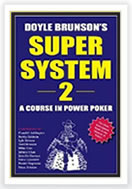 |
Author: Doyle Brunson Publisher: Cardoza Publishing Pages: 640 Pub. Date: 2009 (2nd Edition) Price: $19.77 |
Book Review: Part 1
2006’s Super System 2, featuring Doyle Brunson and a host of other contributors, is one of the most important strategy books in all of poker. This is an omnibus of strategy, offering sections devoted to several different games, and is recommended for beginning through intermediate players.
Doyle Brunson, the “Godfather of Poker,” is responsible for two of the most indispensible poker strategy books of all time, even though they appeared on the market a generation apart. Super System 2, published by Cardoza in 2006, is Brunson’s attempt to update and complement his landmark Super/System (which was itself originally titled How I Made over $1,000,000 Playing Poker). Super System 2 retraces the trail blazed by its predecessor, featuring detailed advice on many games that have become popular in recent years. Included here in addition to material from Brunson himself are contributions from Crandall Addington, Jennifer Harman, Bobby Baldwin (assisted by Mark Gregorich), Lyle Berman, Todd Brunson, Mike Caro, Johnny Chan, Steve Lipscomb, Daniel Negreanu and Steve Zolotov. Most of the contributions are strategy-related, though a few tend toward the frivolous and seem out of place in this context, such as Lipscomb’s advertorial for the then-flying-high World Poker Tour. (Lipscomb is no longer involved with the WPT.) Nonetheless, there is so much good material that despite its hefty price and onerous length (US $34.95 in paperback, 672 pages), it remains a vital part of any serious or aspiring poker player’s book collection.
Separating the wheat from the chaff is important when delving into Super System 2, because the book requires several settings to digest. Most players in fact, will dive into one or two favorite sections and gloss over the rest, which means they’re missing out on what this book really has to offer. An early section by Steve “Stevie Z” Zolotov is key to understanding this: Titled “Specialize or Learn Them All?”, Zolotov’s relatively brief contribution explores whether it’s better to learn one game thoroughly or to learn enough about several different games to be able to take advantage of changing poker situations. Zolotov, a skilled and diverse player himself, makes a convincing case for the latter, which then sets the tone for the game-specific sections that follow.
The meat of the book is impressive indeed. It starts out simply enough, with Jennifer Harman exploring the basic strategies of limit hold’em. Limit hold’em is more popular in live settings than online (where no-limit hold’em dominates, cash-game action), but in Harman’s skilled hands the basics of the game are explored and implemented. As a “gateway” game – one which allows new players to explore poker at minimal financial risk – limit hold’em will likely always enjoy some popularity in live casino settings and therefore warrant inclusion in a book such as this. Harman’s own skills at this variant are formidable, as she’s more than held her own in the famed Bellagio “Big Game” for more than a decade against the best players in the world. Harman lays out in this section a core strategy for success in the simplest games, then explores some of the more modern variations that have gained in popularity, such as short-handed and heads-up play.
From there it’s on to an exploration of limit Omaha hi/lo, also known as Omaha-8, offered by Bobby Baldwin and Mark Gregorich. Baldwin is a holdover from Brunson’s list of contributors to the original Super/System, while Gregorich established himself as a preeminent Omaha player in the Vegas live games a decade ago. They combine here to explain the fundamental concepts behind sound Omaha hi/lo play, often contrasting it against the truisms that many hold’em players hold dead – the better to illustrate the radical differences between the games. Omaha is a drawing game, yet a recurring theme in Baldwin’s and Gregorich’s work is to drive home the point that not all draws are created equal. Combining game, hand and positional knowledge is enough to make a casual player competitive in the lowest Omaha hi/lo games, and from there it’s on to more complex stratagems that open the door to success at higher stakes.
Click Here for Part 2!